
On the Grid
Are you a designer looking for a typeface that combines elegance with function? If so, check out Aubusson, a new face inspired by six centuries of European scenic tapestries. Via Print magazine:
Aubusson, a new typeface from Paris-based Black Foundry, is inspired by the six centuries-old tradition of scenic tapestries born in Aubusson, a small town in Central France. Designer Franck Jalleau immersed himself in studying the patterns and textures of traditional tapestry-making after visiting the Cité Internationale de la Tapisserie, a museum dedicated to preserving the craft.
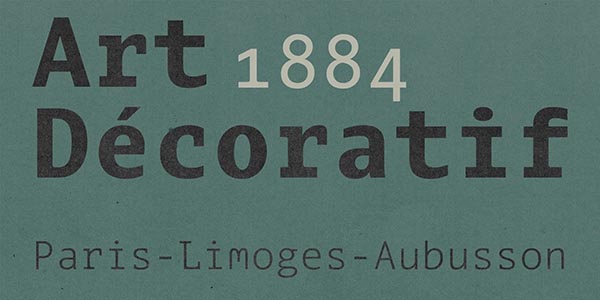
Aubusson captures the essence of the grid-like patterns formed by the interwoven threads while infusing a sense of warmth and organic calligraphy-inspired shapes to reflect the artistry of the tapestries.
In is available in two weights (Light and Black) in both Roman and Italic. Check out Aubusson and Black Foundry.
Terra Daktilo
Some of you may remember the TV series Lou Grant, which ran from 1977 to 1982, in which Ed Asner reprised his Mary Tyler Moore Show character, who was hired as city editor for the (fictional) Los Angeles Tribune daily newspaper. In the early seasons of the show, whenever characters were in the newsroom, you could hear the click-clack of reporters’ typewriters in the background. Sometime during the run of the show, the newsroom upgraded to computers, and the background din was much quieter and less satisfying to those who liked the sound of typewriters.
If you do miss the sound of a typewriter, via Boing Boing, Daktilo has you covered, as it “turns your normal, everyday computer keyboard into a typewriter. An old, clacking, ringing, belligerently loud typewriter.”
daktilo (“typewriter” in Turkish, pronounced “duck-til-oh”, derived from the Ancient Greek word for “finger”) is a small command-line program that plays typewriter sounds every time you press a key. It also offers the flexibility to customize keypress sounds to your liking. You can use the built-in sound presets to create an enjoyable typing experience, whether you’re crafting emails or up to some prank on your boss.
We do recommend you disable it when working in a public space.
Ad Nauseam
If you have been finding that Google search queries have become less useful, it may not be your imagination or poor choice of search terms. Via Wired, something that came out of Google’s recent anti-trust suit was that the company alters queries into the search engine in order to generate more ad revenue, regardless of whether it generates hits that are helpful.
Say you search for “children’s clothing.” Google converts it, without your knowledge, to a search for “NIKOLAI-brand kidswear,” making a behind-the-scenes substitution of your actual query with a different query that just happens to generate more money for the company, and will generate results you weren’t searching for at all. It’s not possible for you to opt out of the substitution. If you don’t get the results you want, and you try to refine your query, you are wasting your time. This is a twisted shopping mall you can’t escape.
To what end?
First, the generated results to the latter query are more likely to be shopping-oriented, triggering your subsequent behavior much like the candy display at a grocery store’s checkout. Second, that latter query will automatically generate the keyword ads placed on the search engine results page by stores like TJ Maxx, which pay Google every time you click on them. In short, it's a guaranteed way to line Google’s pockets.
… It’s unclear how often, or for how long, Google has been doing this, but the machination is clever and ambitious. I have spent decades looking for examples of Google putting its enormous thumb on the scale to censor or amplify certain results, and it hadn’t even occurred to me that Google just flat out deletes queries and replaces them with ones that monetize better.
Rather than bait-and-switch, it’s more like switch-and-bait.
Maybe it’s time to switch to Bing…
Let’s Get Physical
Last week, Netflix discontinued its DVD-by-mail service, ensuring that any movie made before 1980 will be difficult to see. Then again, that may not be the case if Seattle’s Scarecrow Video has anything to say about it. Via a snotty Gizmodo article:
Scarecrow Video is the Catacombes of the cadaverous world of physical media,
Yeah, up yours. At least when the Internet goes out (which it often does in some parts) one can still read a book or watch a DVD. We continue.
Every inch of the shop is covered head to floor in DVDs and VHS. There are aisles dedicated to anime, spy movies, chopsocky, and even more esoteric genres. The foreign film section has titles from countries where the film culture gets little to no attention, like Eritrea. There are more than 146,000 titles among those stacks ranging from recent box office hits to the bizarre, such as an old training video for how to use Microsoft’s Windows 95 hosted by Friends cast members Jennifer Aniston and Matthew Perry.
Chopsocky?
The shop, itself a nonprofit cultural site since 2014, is the last independent shop supplying the option for older physical media, namely VHS and DVDs, to the nearly 734,000 people living in the city. This month, the small store—with its labyrinth of DVD-lined shelves—became one of the last services offering physical DVD rentals to the entirety of the U.S.
Indeed, Scarecrow launched a DVD-by-mail service last month. It’s a bit more expensive than Netflix’s had been, but is said to have more titles than Netflix did at its peak.
Customers have a limit of six DVDs at a time, and everything’s shipped in hard plastic to preserve the integrity of each disk. Customers, for their part, are expected to care for each copy like they’re a treasure.
Unlike some Netflix discs that looked like they had been through a vigorous game of frisbee golf.
More than anything, the service is for cinephiles, those who want to watch something they can’t easily get or struggle to find on any current streaming service. It’s for folks who want to watch a movie with the serenity of no ads, who find the limitation of having only a certain number of movies or shows to watch at a time—in many ways—freeing.
So if you have trouble finding older movies on streaming platforms and the ads on Pluto TV bug you, you may want to check out Scarecrow Video.
Hive Mind
In an old European tradition called “telling the bees,” it was important that the insects be kept apprised of major events in a beekeeper’s family: deaths, births, marriages, departures, and returns. If the bees were kept in the dark, it was believed that some misfortune would befall them, such as the bees leaving, stopping honey production, or dying. (Hmm…maybe this could explain colony collapse disorder; have modern beekeepers been keeping up this tradition?)
Via Atlas Obscura, Slovenia in particular has a long history of beekeeping which continues to this day—it’s been estimated that one in every 200 Slovenians keeps bee colonies. And the Slovenian Beekeepers’ Association, a nearly 150-year-old education, research, and training organization, boasts 8,000 members. As befits such devotion and dedication to beekeeping, it’s no surprise that beehives have taken on a unique structure.
Drive through the verdant countryside, and you’ll notice hobbit-sized huts, similar in appearance to garden outbuildings or she-sheds. But these small structures aren’t filled with landscaping tools or craft supplies. Instead, they’re apiaries that house unique hives, known as Alberti-Znideric (or AZ) hives. Invented at the turn of the 20th century by beekeeper Anton Znidersic, the hives—kranjichi in Slovenian—take their name from their inventor whose design was inspired by a leaf hive system by German teacher and beekeeper Adolf Alberti.
They are more than just hives.
Inside, the apiaries are a mix of workspace and living room. Depending on their location, they can include heat or air conditioning. Some are large enough to hold the extractor and other machinery needed to process the honey, as well as space for the beekeeper to hang out. “You’ll see a lot of bee houses that have beds or a table and chairs in them,” says Suzanne Brouillette, the owner of Slovenian Beekeeping.
But the most distinctive aspect of these apiaries are the colorful, painted panels, often featuring illustrations, known as panjske koncnice.


Hackenberg-Photo-Cologne / Alamy
The first panels were created in the 18th century. Back then, beekeepers thought they helped the bees navigate to their own hives. “Today, we know that’s not the case, that bees remember the location of the right hive,” Kozmus says. Also, most beekeepers at the time were illiterate and the panels, which were often painted by traveling artists, told stories about their lives.
The panels often told stories from the Bible, told moral tales of drinking and infidelity, illustrated historical events, or offered social commentary. Maybe today’s US beekeepers should take a leaf from the Slovenians. It could take the sting out of today’s pollinator crisis.
How Do You Like Them Apples
Do you want to use social media—specifically Mastodon, the open-source ostensible alternative to TwitterX? But, are you still using an Apple II? Well, fans of retrocomputing, Colin Leroy-Mira has you covered. Via Boing Boing, he has created a version of Mastodon that will in fact run on a late 1970s computer. “All the good features are included, such as ‘unfollow’ and ‘block’, and none of the bad features such as ‘account creation’ and ‘polls.’” Adds Leroy-Mira:
I’ve made a binary release of my Mastodon client for the Apple 2. It has been mostly tested on an Apple //c, and works on ][+, IIe, //c, //c+, IIe enhanced, IIe Platinum and IIgs according to emulator testing.
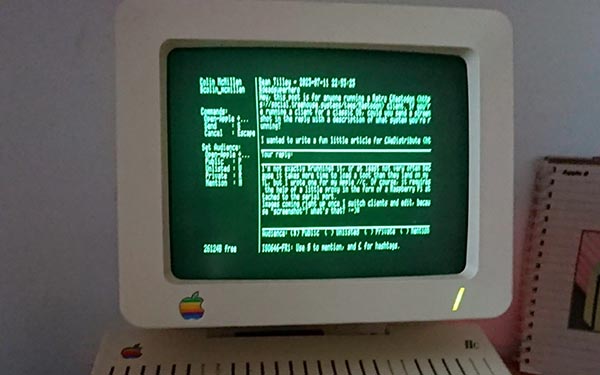
Maybe Twitter X itself would be usable on this platform.
Time Out
Do you like to nap? Sure, we all do. And did you know that the best nap is about 10 to 20 minutes long, as any longer will have the unintended consequence of sending you into deep sleep, making it harder to wake back up, and potentially screwing up your entire sleep cycle.
That’s the logic behind Japanese startup GiraffeNap’s eponymous napping pod. Via Core77, the M.O. behind the GiraffeNap is that by napping vertically, you can manage to catch the beneficial and rejuvenating short power nap without falling into deep REM sleep.

Didn’t the future people in Woody Allen’s Sleeper have these? The interior is designed to comfortably support the body whilst still remaining generally vertical.

And these are adjustable. There is also a ventilation system so there’s no chance of suffocating. If you don’t like the futuristic space-pod look, the “entry-level” Forest model is made primarily of plywood.

The company also says they are earthquake-resistant. No indication of price, but, really, can you put a price on peace of mind? (Actually...yes.)
Graphene Sweats It Out
Was it a good week for graphene news? It’s always a good week for graphene news! A graphene-based sensor that can detect biomarkers, such as glucose in sweat. From (who else?) Graphene-Info:
The researchers said sweat is a rich source of biomarkers, which are substances that indicate the state of health or disease in the body. However, measuring biomarkers in sweat is not easy, as they are present in very low concentrations and vary depending on factors such as exercise, diet, and environment. Previous sweat sensors have faced limitations such as low sensitivity, limited surface area, and poor stability.
However:
The laser-reduced and patterned stable conductive nanocomposite on the porous graphene electrode provides the resulting glucose sensor with an excellent sensitivity of 1317.69 µA mm−1 cm−2 and an ultra-low limit of detection of 0.079 µm. The sensor can also detect pH and exhibit extraordinary stability to maintain more than 91% sensitivity over 21 days in ambient conditions.
It's a low-cost, highly sensitive, and stable platform that can help with early detection and monitoring of various biomarkers for disease diagnosis.
Fatal Stairs
The late comedian Mitch Hedberg once said, “An escalator can never break. It can only become stairs.” Well, perhaps, but as this video attests, things can go horribly wrong. Adds Boing Boing:
An escalator's fail-safes were not safe, turning into a loose, freely spinning nightmare. The escalator was designed so the stairs remained stairs, and people were speedily but calmly chucked into a growing pile of fine people.
Yet another reason to prefer the proper stairs.
Toyz on the Hood
Mental Floss asks (and answers) an interesting question: “Why Don’t Cars Have Hood Ornaments Anymore?” Sure, while the WhatTheyThink company Rolls Royce still does, most cars these days lack the once-ubiquitous hood ornament. Pourquoi?
Back in the early 20th century when cars first hit the market, the radiator cap was on the outside and had a “MotoMeter” mounted on top of it, which was basically a thermometer that monitored engine coolant temperature before a dashboard gauge was invented to keep an eye on engine heat.
To offset the somewhat unpleasant aesthetic of the cap, automakers disguised them with what they dubbed car mascots, which were meant to be attractive hood accessories made of brass or bronze with a chrome-plated finish.
The term “car mascot” eventually evolved into the term “hood ornament.”
Drivers weren’t limited to what automakers offered, either. They could opt for mascots like Mickey Mouse or Charlie Chaplin. Some owners even sought out glass ornaments by French artist René Lalique, whose eye-catching sculptures were the ultimate status symbol. Others carried a political message: In 1923, cars sported a “Keep Coolidge” emblem to show support for presidential incumbent Calvin Coolidge.
He was pretty silent about how he felt about that.
After about 1930 or so, radiator caps and temperature-monitoring technology moved under the hood, but the hood ornament trend persisted.
Carmakers took inspiration from mythological figures, animals, and their own logos to create the ornaments. The Spirit of Ecstasy was a familiar sight; so was Jaguar’s Leaper cat, Bugatti’s dancing elephant, and the flying B on a Bentley. Mercedes-Benz mounted their own logo: a three-pointed star.
As cars improved and the interstate system was built, eventually two trends consigned the hood ornament to the automotive museum. The first was aerodynamics, as a bulky ornament could increase drag and potentially affect gas mileage, particularly on the highway. The other was pedestrian safety: it’s bad enough getting hit by a car, but worse if there is an object on the hood that can impale you.
The mascots experienced a brief resurgence in the 1970s, this time on springs so they’d have some give in the event of an accident. At least one automaker at Chrysler argued they even served a highly practical purpose, giving drivers a frame of reference to keep to the center of the road and better understand where the front fender was to avoid collisions.
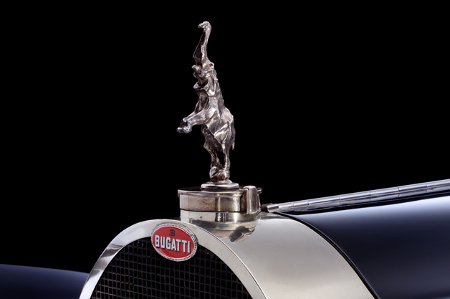
But the resurgence of interest in hood ornaments was fleeting. And, given the recent surge in car-pedestrian collisions, it’s probably just as well. Also, there was the issue of theft. For a detailed history of hood ornaments, check this out.
Car ornaments have also been known to be dangerous for drivers, as Sammy Davis, Jr., could well have told you. In 1954, he was driving his Cadillac Eldorado from Las Vegas to Hollywood and, while tooling through Cajon Pass in the San Bernardino Mountains, he rear-ended a car that had stopped on the road. Unfortunately, his model of Eldorado had a steering wheel with a cone-shaped ornament in the center of it—it was variously called the “Bullet Wheel” or the “Steering Wheel of Death”—and during the impact, Davis’ head hit the steering wheel and, well, that’s how he lost an eye. (They should have called the car the Chevy Impaler.)
Around the Webb, Part the Continuing: Impossible Galaxies
It was bound to happen eventually. The James Webb Space Telescope saw something that shouldn’t exist, something that could potentially “break” cosmology. These were a bunch of early galaxies—which were spotted forming as early as 500 million years after the Big Bang—that were impossibly bright. Says LiveScience:
Brightnesses of their magnitude should only come from massive galaxies with as many stars as the Milky Way, yet these early galaxies took shape in a fraction of the time that ours did.
The discovery of these impossibly bright galaxies had the potential to upend how physicists understand galaxy formation—and even what has become the standard model of cosmology. Now, that isn’t necessarily a bad thing; it’s kind of what science does, causes scientists to come up with new explanations as more evidence is discovered. But, still, no one likes to go back to the drawing board.
Happily, some other scientists may have figured out what’s going on. It’s possible that these galaxies aren’t that massive at all — they’re just unusually bright. How does that help?
“Typically, a galaxy is bright because it’s big. But because these galaxies formed at cosmic dawn, not enough time has passed since the Big Bang. How could these massive galaxies assemble so quickly?” Senior study author Claude-André Faucher-Giguère, an astrophysicist at Northwestern University, said in a statement. “Our simulations show that galaxies have no problem forming this brightness by cosmic dawn.”
It’s generally held that “protogalaxies” reach cosmic adolescence about 1 or 2 billion years after the universe’s formation, more than twice the age of the galaxies the Webb found. Hence everyone’s consternation.
To investigate what could have given these galaxies their strange sparkle, the researchers created a model of galaxy formation and ran it through a supercomputer — simulating the swirling, clotting gas of the early universe as it turned into stars, which in turn formed into galaxies.
By carefully accounting for the mass, energy, momentum and chemical composition of the young universe, the researchers found that stars at this early time could have formed in sudden, rapid bursts after years of quiescence. Known as “bursty star formation,” the process is unlike the steady rate of star birth in today's universe and could explain why the early universe is so bright.
Ever had “bursty star formation”? There’s actually a cream for it. We continue.
If the bursty star formation hypothesis is correct, the galaxies that the JWST detected are brighter because we are viewing their stars form in these sudden bursts, not because they contain as many stars as those in the present day.
If they’re right, our standard view of the universe holds—which is kind of a bummer if you like to have your universe shaken up every now and then. “But astronomers will need to take more precise readings of the mysterious galaxies at cosmic dawn before they can know for certain.”
Foot Court
When you think of food, what’s second thing that comes into your mind? Of course: footwear. Obvious, isn’t it? Why this odd association of footwear with food is a mystery, but Food & Wine highlights two recent collaborations.
Skechers, the sneaker maker, also has a couple of retail locations in Southern California, and the Skechers store in Gardena recently opened a restaurant.
According to KTLA, the Food Spot opened at the Gardena Skechers store at the beginning of May but began to pick up more attention in recent weeks thanks to recent coverage on Eater and SFGate, as well as a plethora of social media posts. Its arrival was facilitated by stealing 900 square feet of the retailer’s floor space to create a commercial kitchen. The only food offerings that aren’t made-to-order on-site are those “pretty great” French fries, which are frozen.
Apparently, the restaurant looks a lot like a Costco and offers the usual food court fare: Nathan’s hot dogs,pizza, and a double cheeseburger.
His vision has proven to be a good one; the Food Spot serves around 2,000 customers every week. “[T]he most important thing to me was the quality of food,” Greenberg added. “Because I relate the quality of the food, it’s got to be as good as the product that we sell, whether you wear our product, or you ingest and chew our product.”
Charlie Chaplin, where are you now?
Elsewhere, in even odder food/shoe collaborations, in preparation for Halloween, Hershey’s—the chocolate-maker—and Crocs—the wiffleball-inspired shoe manufacturer—are collaborating on a line of Halloween candy-themed shoes.
The Hershey x Crocs kicks come in two versions: one is a deep chocolatey brown that conjures images of the OG Hershey chocolate bar, and the other is a Reese’s orange number that looks like …well, you get it. Both styles are available in a range of sizes for adults and children, and they can be further customized with a set of exclusive Jibbitz charms shaped like Hershey’s Kisses, Hershey Bars, and Reese’s Peanut Butter Cups.
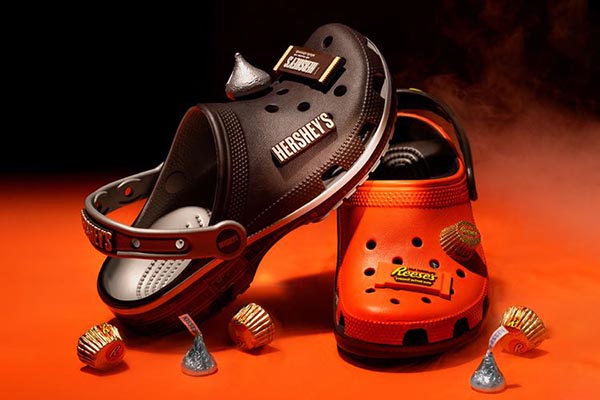
This is not the first food-themed Crocs—there were Crocs x Pop-Tarts, Taco Bell-themed Crocs, and Margaritaville Crocs—and probably won’t be the last. We’re not sure we’d ever wear these in public—we’d probably leave behind a trail of plastic candies—or even in private, for that matter.
We can’t wait for Crocs to partner with Morton’s Steakhouse.
This Week in Printing, Publishing, and Media History
October 2
1789: The United States Bill of Rights is sent to the various States for ratification.
1890: Groucho Marx (né Julius Marx) born.
1925: John Logie Baird performs the first test of a working television system.
1959: Rod Serling’s anthology series The Twilight Zone premieres on CBS. The first episode is “Where Is Everybody?”
1985: American essayist and journalist E. B. White dies (b. 1899).
2004: American photographer Richard Avedon dies (b. 1923).
October 3
1896: English author and poet William Morris dies (b. 1834).
1949: WERD, the first black-owned radio station in the United States, opens in Atlanta.
1954: American guitarist and singer-songwriter Stevie Ray Vaughan born.
1957: The California State Superior Court rules that Allen Ginsberg’s Howl and Other Poems is not obscene.
1987: French playwright and screenwriter Jean Anouilh dies (b. 1910).
2005: English actor and screenwriter Ronnie Barker dies (b. 1929).
October 4
1535: The Coverdale Bible is printed, with translations into English by William Tyndale and Myles Coverdale.
1582: The Gregorian Calendar is introduced by Pope Gregory XIII.
1669: Dutch painter and illustrator Rembrandt van Rijn dies (b. 1606).
1880: American newspaperman and short story writer Damon Runyon born.
1883: First run of the Orient Express. (No murder on it…yet.)
1927: Gutzon Borglum begins sculpting Mount Rushmore.
1941: Norman Rockwell’s Willie Gillis character debuts on the cover of The Saturday Evening Post.
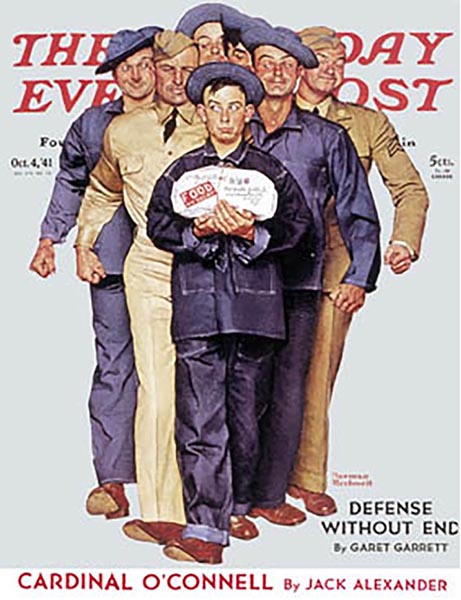
1957: Sputnik 1 becomes the first artificial satellite to orbit the Earth.
1985: The Free Software Foundation is founded.
1989: English actor and screenwriter Graham Chapman dies (b. 1941).
October 5
1947: In the first televised Oval Office address, President Truman asks Americans to reduce their consumption of grain in order to help starving Europeans.
1949: English biographer, novelist and critic Peter Ackroyd born.
1970: The Public Broadcasting Service (PBS) is founded.
2011: American businessman, co-founder of Apple Inc. and Pixar Steve Jobs dies (b. 1955).
October 6
1723: Benjamin Franklin arrives in Philadelphia at the age of 17.
1927: Opening of The Jazz Singer, the first significant “talkie” movie.
2010: Instagram is founded by Kevin Systrom and Mike Krieger.
2020: Dutch-American guitarist, songwriter, and producer Eddie Van Halen dies (b. 1955).
October 7
1777: The Americans defeat the British in the Second Battle of Saratoga, also known as the Battle of Bemis Heights.
1849: American short story writer, poet, and critic Edgar Allan Poe dies (b. 1809).
1885: Danish physicist and philosopher and Nobel Prize laureate Niels Bohr born.
1919: KLM, the flag carrier of the Netherlands, is founded. It is the oldest airline still operating under its original name.
1959: The Soviet probe Luna 3 transmits the first-ever photographs of the far side of the Moon.

October 8
1921: KDKA in Pittsburgh's Forbes Field conducts the first live broadcast of a football game.
1962: Der Spiegel publishes an article disclosing the sorry state of the Bundeswehr, and is soon accused of treason.
1982: Cats opens on Broadway and runs for nearly 18 years before closing on September 10, 2000.















Discussion
Only verified members can comment.